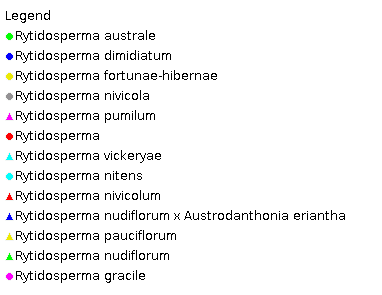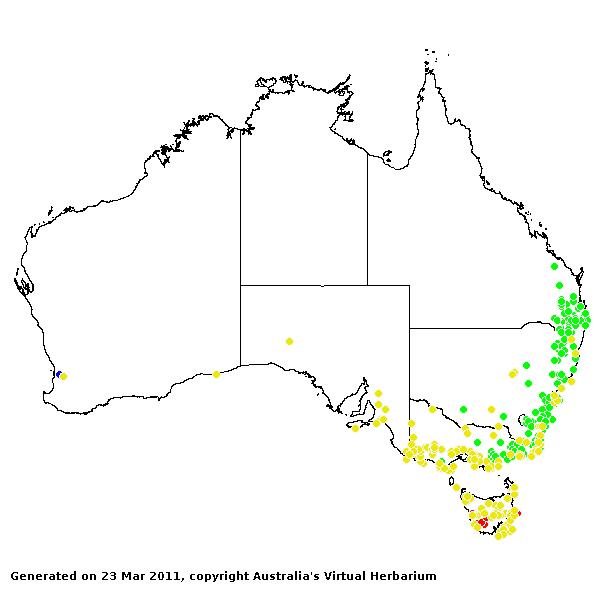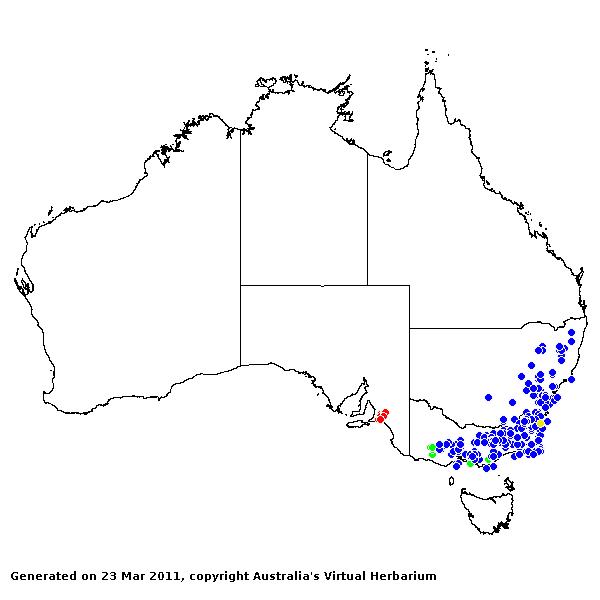Rytidosperma Syn. Pl. Glum. 1: 425 (1854).
Derivation:. From the Greek rhytis (wrinkle) and sperma (seed), referring to the back of a larvae mistaken for the seed.
Syn: Erythranthera Zotov.
Taxonomic revisions, nomenclatural references:. J.W.Vickery, Contr. New South Wales Natl Herb. 2: 249–325 (1956) (as Danthonia); H.E. Connor and E. Edgar, New Zealand Journal of Botany 17, 311–337 (1979); S.W.L.Jacobs, Taxon 31: 737–743 (1982); H.P.Linder, Telopea 6: 597–627 (1996).
Key references (keys and floras):. G.Bentham, Flora Australiensis 7: 590–596 (1878) as Danthonia in part; E.E.Henty, Manual Grasses New Guinea 51 (1969) as Danthonia in part; B.K.Simon, Key to Australian Grasses 90–94 (1993)as Danthonia in part, 120 (Erythranthera); S.W.L.Jacobs and S.M.Hastings, Flora of New South Wales 4: 548–557 (1993), as Danthonia in part and 559–560 as Erythranthera; N.G.Walsh, Flora of Victoria 2: 527–543 (1994) as Danthonia in part and Erythranthera; D.I.Morris, Student's Flora of Tasmania 4B: 304–318 (1994) as Danthonia in part and Erythranthera; E.Edgar and H.E.Connor, Flora of New Zealand 5: 460–490 (2000), incl. Austrodanthonia and Notodanthonia; D.Sharp and B.K.Simon, AusGrass (2002);K.Mallet (ed.), Flora of Australia 44B: Poaceae 3: 64–70 (2005); S.W.L.Jacobs, R.D.B.Whalley & D.J.B.Wheeler, Grasses of New South Wales, 4th ed, 361--363 and 264–265 as Erythranthera (2008); S.W.L.Jacobs, R.D.B.Whalley & D.J.B.Wheeler, Grasses of New South Wales, 4th ed, 361–362 (2008).
W.D.Clayton & S.A.Renvoize, Genera Graminum (1986), genus (272).
Native. 35 species, from Australasian region, and South America. 9 species in Australia, NSW, Vic, and Tas. Also New Guinea and New Zealand.
Habit. Perennial, tufted. Leaf blades narrow, hard, woody, needle-like (rarely) or not needle-like (often disarticulating). Ligule a fringed membrane (very short) or a fringe of hairs.
Inflorescence. Inflorescence paniculate (sometimes almost a raceme, or reduced to a single spikelet).
Spikelets. Spikelets laterally compressed, pedicelled; with naked rachilla extension. Fertile spikelets cuneate or obovate, green to purple, laterally compressed, disarticulating above glumes.
Glumes. Glumes more or less equal, shorter than spikelet or about equal to spikelet or exceeding florets, long relative to adjacent lemmas, usually hairy or hairless (rarely), scabrous, pointed (acute), awnless, similar (papery, persistent). Lower glume 5–7 nerved. Upper glume 5–7 nerved.
Florets. Fertile florets 2–8. Lemmas similar in texture to glumes (soft to leathery), entire at apex or incised, pointed, deeply cleft or not deeply cleft, rarely mucronate or awned, 7–9 nerved, with nerves confluent towards tip, not keeled (rounded on the back). Awns 1 or 3, the median different in form from laterals (when laterals present), from a sinus, non-geniculate or geniculate, much shorter than body of lemma to much longer than body of lemma. Lateral awns (when present) shorter than median to about equalling median (straight, terminating the lobes as setae). Lemma hairs when present (as is usual), in tufts, in transverse rows (with transverse rows of tufts or marginal tufta) or not in transverse rows (villous). Palea relatively long, entire (truncate) or apically notched (minutely bilobed), thinner than lemma, 2 nerved, 2 keeled, glabrous or hairy. Palea keels wingless, scabrous. Distal incomplete florets underdeveloped. Callus short, blunt. Lodicules 2. Stamens 3. Stigmas 2. Disseminule a caryopsis enclosed in but free of lemma and palea. Grain small, golden-brown, obovate, longitudinally grooved (or somewhat hollowed), compressed dorsiventrally, glabrous. Hilum short (usually punctiform). Embryo large.
Kranz Anatomy. C3.
2n = 24, 48, 72, 96, and 120, 4–20 ploid.
Habitat. Helophytic, mesophytic. Generally open, upland grasslands, or rocky habitats. Mostly species of open habitats.
Classification. Danthonioideae.
Notes. Australian agrostologists follow the concepts of Linder and Verboom (1996), who analysed the danthonioid group using cladistic methods and recognised the genera Austrodanthonia, Rytidosperma, Notodanthonia, Chionochloa etc. based on small but distinct morphological characters. Rytidosperma is distinguished by the lemma hairs being arranged in two untidy rows and by the callus being up to twice the length of the internode of the spikelet axis (B.K.Simon).
Types Species. R. lechleri Steud.
Biogeographic Element. Clifford & Simon 1981, Simon & Jacobs 1990: Gondwanan.








